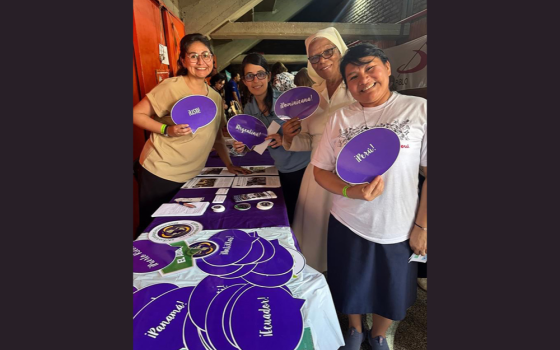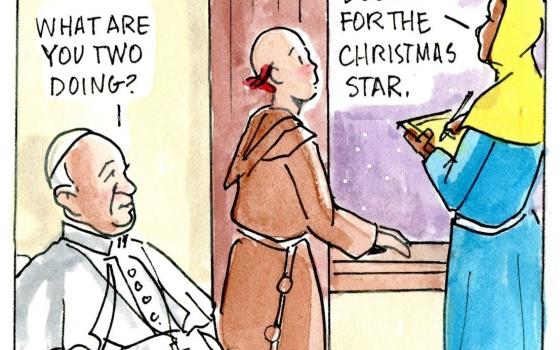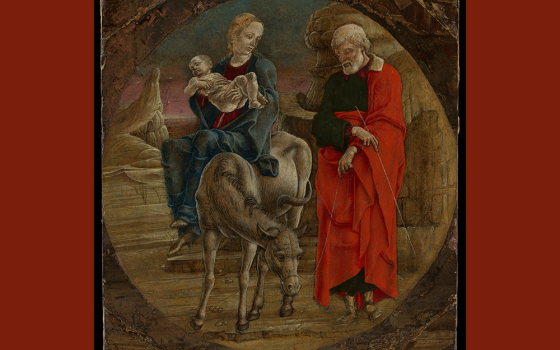
Mother Mary Joseph visiting Maryknoll Sisters working at St. Paul’s Hospital, Manila, Philippines, 1940
 ON THE THRESHOLD OF THE FUTURE: THE LIFE AND SPIRITUALITY OF MOTHER MARY JOSEPH ROGERS, FOUNDER OF THE MARYKNOLL SISTERS
ON THE THRESHOLD OF THE FUTURE: THE LIFE AND SPIRITUALITY OF MOTHER MARY JOSEPH ROGERS, FOUNDER OF THE MARYKNOLL SISTERS
By Claudette LaVerdiere, MM
Published by Orbis Books, $20
First, some disclaimers. I'm a sucker for biographies of women who founded religious communities. Almost always, they are fascinating, powerful women who followed a call to launch and lead new foundations in the face of daunting odds. This one is no exception.
Second, I once thought about becoming a Maryknoll sister myself. The enchantment was fleeting because I was very young at the time, but I've grown in my respect for this community, especially as I've come to know some of its members personally, and as I was moved by the story of Srs. Maura Clarke and Ita Ford, who were martyred in El Salvador in 1980.
This year is the 100th anniversary of the Maryknoll sisters, an appropriate time for a "jubilee biography" of their founder, Mother Mary Joseph Rogers, or, as this author says her family called her -- and I would prefer to call her -- Mollie.
This is a solid book, giving the reader an excellent picture of the founder of the Maryknoll Sisters. It might benefit from a couple of rollicking stories but, hey, you can't have everything in a spiritual biography!
The book is divided into three parts: the life of Mollie Rogers, the foundations of the Maryknoll vision -- including some important historical context -- and the spirituality of the sisters' founder.
I found the life of Mollie the most fascinating section. She was raised in an Irish Catholic family whose members were no strangers to discrimination, but the family held its own with the Protestant Yankee establishment in Boston. She was sent to public schools to maximize her chances for success, and later to Smith College in Northampton, Mass., where she earned her bachelor's degree.
The author gives us a good feel for Mollie the person. She was in no sense an insular Catholic. In fact, she found the inspiration for her missionary vocation not in Catholic groups, but in the Protestant Student Volunteer Movement for the Foreign Missions that flourished on the Smith College campus. That movement sent idealistic young people overseas as missionaries. There was nothing comparable in the American Catholic church at the time.
That was amazing for 1906: Mollie saw Protestants not as rivals, but as models. Here was a woman comfortable with religious diversity. She was moved by an ecumenical inspiration to found the Maryknoll Sisters. Who knew?
At the same time, she was quite obviously a serious and prayerful Catholic who later teamed up with Fr. Joseph Walsh -- founder of the male branch of Maryknoll -- to create a community that eventually became the Maryknoll Sisters. Although she was not a 21st-century feminist, she understood the power of women in the early 20th century. She was pleased, for example, when the Maryknoll Sisters became independent, and were not "auxiliaries" of the men.
When she sent the first sisters to China on mission, she was not content to serve as some distant CEO. She followed them to China and spent several months immersed in the culture, experiencing the hardships, learning firsthand.
From the beginning, she accepted sisters from any culture of the world where Maryknoll worked. That represented an amazing openness to other races and cultures for the time, though the author makes quite clear that as the 20th century moved on, the Maryknoll Sisters, like most groups, had to come to terms with varieties of racism in different and often subtle expressions.
The second part of the book provides important historical context. For example, we learn more about the vibrant Protestant missionary revival of the time, and the fact that it was only in 1908 that the Vatican took the United States off of its official list of "mission countries." That facilitated an American Catholic interest in foreign missions.
The section on Mollie's spirituality emphasizes "binary oppositions." These include contemplation and action, unity and diversity, individuality and the common good. It reveals Mollie's prayerfulness and spiritual depth, her obvious reliance on God as well as her sisters. It did not surprise me that her model was Teresa of Avila.
However, what I thought I might find in this section but did not was an overt discussion of Mollie's view of mission. Did she believe that her sisters were sent to convert those of other faiths? Clearly, she thought bringing the Gospel message to other lands was a positive good, but how did she understand evangelization? Indeed, what did she think of other faith traditions outside Christianity? Maybe the documentation for this does not exist, but if it does, it would have enriched the book.
Mollie Rogers died in 1955 and so did not experience the Second Vatican Council, which, after "meeting" her in the book, I suspect she would have loved. Nor did she watch her sisters move strongly into work for human rights and basic economic justice in many parts of the world. But I suspect she would have loved that, too.
Overall, for anyone seeking to understand the spirit and founding of Maryknoll, this book is a must-read.
[Loretto Sr. Maureen Fiedler is the host of "Interfaith Voices," a public radio show heard on 62 radio stations in North America.]




